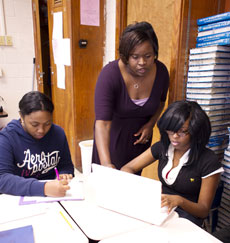UAB Grants Help Local Teachers Inspire Digital Success
By Shelley Stewart
 Middle school teacher Jameka Thomas (center) says her job is to challenge high-achieving students to help them reach their full potential.In the early 20th century, iron ore from Birmingham’s Red Mountain fueled the young city’s rapid growth. One hundred years later, information has replaced iron as the driving force behind economic success, but the mountain—the scenic backdrop to UAB, the region’s new powerhouse—is still a symbol of opportunity.
Middle school teacher Jameka Thomas (center) says her job is to challenge high-achieving students to help them reach their full potential.In the early 20th century, iron ore from Birmingham’s Red Mountain fueled the young city’s rapid growth. One hundred years later, information has replaced iron as the driving force behind economic success, but the mountain—the scenic backdrop to UAB, the region’s new powerhouse—is still a symbol of opportunity.
The Red Mountain Writing Project (RMWP), founded in 2004 and sponsored by UAB’s School of Education and College of Arts and Sciences, is dedicated to helping teachers at all grade levels find and adopt innovative strategies for literacy instruction. Some of the most exciting innovations involve tablet computers, e-book readers, and other high-tech tools, which are poised to bring a revolution in education, says Tonya Perry, Ph.D., director and principal investigator of the RMWP since 2008.
“Being prepared for a digital world is critical for all young people,” says Perry, an assistant professor in the Department of Curriculum and Instruction in the School of Education. Although they are making greater use of technology, many urban schools, facing chronic budget constraints, don’t always have the means to give students this vital experience, she says.
In 2012, the RMWP awarded four public-school grants of $1,000 each to bring new digital tools into local classrooms. “Research shows that students who participate in innovative work like this definitely outperform those who aren’t prepared,” Perry says.
Adventures in Education
Rod Leonard, a teacher at Bush Hills Academy in Birmingham, bought iPads to improve literacy among his seventh- and eighth-grade students. “They take technology in stride, and I can see that they’re engaged,” Leonard says. “They are having so much fun that some of them didn’t even realize they would get a grade for what they are doing.”
Leonard introduces students to tools such as Prezi, cloud-based software that allows them to create interactive stories and other presentations. He makes sure assignments are geared toward his students’ particular interests, helping them explore further through research and special projects. “These kids already like to read, but they mainly like to read what they like to read,” Leonard says. Linking students from their interests to a new world of literacy is an important role of technology, Perry notes.
Kristi Williams, who teaches at Smith Middle School in Birmingham, and Nieshel Fall, who teaches at Forest Hills Middle School in Fairfield, both encouraged similar interaction and creativity with Amazon Kindle e-readers.
Embracing the Challenge
Meanwhile, Jameka Thomas, an eighth-grade social studies teacher at Davis Middle School in Bessemer, used her grant funding to buy three digital camcorders. “My work is targeted to challenging urban high achievers—the top 2 percent, or those who have an A average,” Thomas says. When the class is doing a unit on Greece or Africa, for instance, these students will add an independent study and produce a project on the subject, Thomas explains. “They can create a play, a newscast, a slideshow, a cartoon, or anything else they choose—and I emphasize that the choice is theirs, which is very important,” she says.
Thomas’s program lasts three to four months, during which time each advanced student produces three ambitious projects in different mediums, mastering three different skills. They also read the same material and take the same tests as the rest of the class, Thomas explains.
Working with these students is a homecoming for Thomas. “I sat right here at a desk at Davis Middle School,” she says. “I know how frustrated these high achievers can feel. It helps to have classwork that really challenges them.”
Thomas makes sure that is the case with her students. At the end of each term, each “young researcher” must present his or her best project to an expectant audience of family, friends, and faculty. “That’s a pretty big challenge for anyone,” Thomas says.
It’s amazing how far a child can go when given an encouraging push, Perry adds. “Seeing that they can master skills they didn’t even know they could ignites a spark in these students,” she says. “Using technology to inspire students, I know we make a difference.”